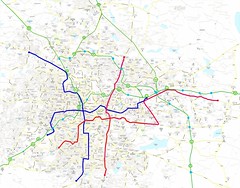Commuter Rail - Will it ever materialize ?


Most of us are aware that the CTTP-2007 report had recommended a Commuter /Sub-urban rail system for the city, totalling 204.0km (this includes city & suburban services upto Tumkur, Hosur & Ramanagaram). A few sub-urban trains are in operation & are being run by Southwestern railways (SWR), but the system is not of much help to urban commuters.
Please also see earlier discussions on this subject here, here & more recently here.
Within the city & the more developed suburbs, the following (twenty-two) stations already exist, but many of these stations are not much used :
1) Yelahanka
2) Chikkabanavara
3) Kodigehalli
4) Lottegollahalli
5) Hebbal
6) Yeswantapur
7) Chennasandra
8) Banaswadi
9) Krishnarajapuram
10) Bangalore East
11) Whitefield
12) Malleswaram
13) Cantonment
14) Byappanahalli
15) City Station
16) Nayandahalli
17) Gnanabharti
18) Kengeri
19) Bellandur Rd
20) Karmelaram
21) Heelalige
22) Anekal Road
Except for four of the larger inter-city train stations, ie. (6), (9), (13) & (15), the other 18 stations are used very little. Can city service trains be run through these stations & could they be put to better use than they are at present ? On the drawing below, one can see the planned Metro tracks (phase 1 & also phase 2, as will most likely be built) in the backdrop of SWR's tracks :

( Click for larger image )
The following CTTP recommended routes would certainly be needed since the areas covered by CRS are not going to be served by Metro routes :
a) Kengeri to City Stn - 13 km
b) City Stn to Whitefield (via Cant R'ly Stn, Baiyyappanahalli) - 24 km
c) City Stn to Baiyyappanahalli (via Hebbal) - 23 km
d) Lottegollahalli to Yelahanka - 7 km
e) Banaswadi to BMA boundary (via Bellandur rd) - 29 km
( Total = 96 kms )
The fewer interfaces with Metro might not pose obstacles & could be overcome by connecting bus services to CRS stations. There are only 22 stations over the 96 kms of track. Thus, the average distance between stations is over 4.3km - additional CRS stations would be necessary - some ideas are as follows (marked with blue spots on the map above) :
a) On Kengeri-City Stn route: (23) near RV Engg College; (24) Deepanjali Nagar Metro stn; (25) Hosahalli main rd.
b) On City Stn-Whitefield route: (26) Seshadripuram (Sivananda store); (27) Jeevanahalli; (28) Beniganahalli (ORR); (29) Devasandra; (30) Hoodi; (31) Sadarmangal Ind Area.
c) On City Stn-Baiyyappanahalli route: (32) Jalahalli (ORR); (33) MS Ramiah rd; (34) Gundappa rd; (35) Kanaka nagar; (36) Kadugondanahalli.
d) On Banaswadi-BMA boundary route: (37) Beniganahalli (ORR); (38) Kaggadasapura; (39) Chinnappanahalli; (40) Varthur rd; (41) Sarjapura rd; (42) Chandapura (Hosur rd).
These additional stations would reduce the average distance between stations to about 2.3km, which is more appropriate for a suburban rail system.
SWR might have it's reasons for repeatedly rejecting operation of city rail services in Bangalore - such rail systems are faring poorly in almost every city in the country barring Mumbai, but then in India, city rail systems are directly being operated by divisions of Indian railways whose primary focus area is the operation of inter-city train services. Further, the other transport systems in use in the cities (such as buses, taxis, etc.) were never planned nor integrated for easy transfer of passengers between different modes. Each operated independently on it's own, sometimes even competing with one another & making commuting difficult for people. Thus, most cities continue to have transport systems that are not well-knit & therefore, inefficient, & this also explains why city rail systems have fared so poorly in the country.
We now have a situation where SWR has a lot of assets such as tracks, real estate & stations, but is clearly not the best option to build & operate the city /suburban rail system. It might be best if BMRCL could become the operator for CRS, sharing the infrastructure with SWR.